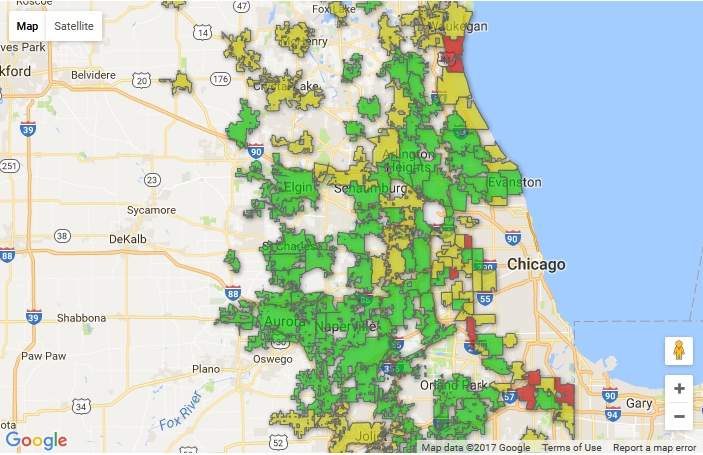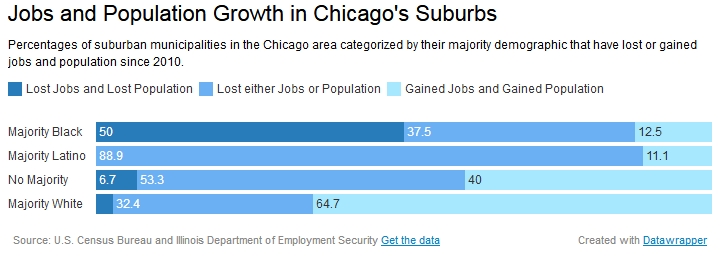The invisible barriers that generally separate people by race and income in the Chicago region also appear to serve as barriers to population growth and job growth, critical factors for strong economic development.
A Metropolitan Planning Council analysis shows that suburban municipalities that witnessed sharp declines in white population between 2000 and 2010 have continued to lose population, lose jobs or lose both since 2010, particularly majority-black and majority-Latino suburbs. In addition to struggling with job and population growth, these areas are home to fewer jobs overall and the jobs located there are typically low-wage jobs with few opportunities for meaningful advancement.
The analysis highlights the continuing struggles of the Chicago region to overcome its legacy of racial and economic segregation. It also further illustrates how race and income may influence the flow of resources and investment in the region.
MPC analyzed data from the U.S. Census Bureau and the Illinois Department of Employment Security (IDES) to identify trends in population growth and job growth since 2010. The analysis focused on 134 Chicago-area suburbs in Cook, DuPage, Kane, Lake, McHenry and Will counties for which jobs data was available from IDES.
Some majority black suburbs in southern Cook County are among those suffering the deepest job losses.
From 2000 to 2010, Calumet City saw its white population plummet by more than 63 percent from about 13,000 to less than 5,000. Since 2010, Calumet City has suffered the region’s sharpest decline in jobs, losing 29 percent between March 2010 and March 2016, according to MPC’s analysis. By comparison, regionwide, jobs increased by almost 12 percent during that span.
Calumet City also saw a slight decline in population from July 2010 to July 2015, according to Census Bureau population estimates. The Census is slated to release 2016 population estimates in May.
There are just 160 jobs for every 1,000 residents in Calumet City, among the lowest rates in the region. Regionwide, there are about 420 jobs for every 1,000 residents. And more than 60 percent of the roughly 6,000 private sector jobs in Calumet City are in the retail trade or accommodations and food services industries—the two lowest-paying sectors in the region, according to IDES data from March 2016. About 21 percent of all private sector jobs in the region are in those two industries.
The second-steepest fall in jobs occurred in Riverdale, another majority-black suburb just beyond Chicago’s southern border. Riverdale lost more than 23 percent of its jobs between March 2010 and March 2016. The job losses followed a decade where Riverdale saw its white population fall by nearly 67 percent from about 1,500 in 2000 to about 500 in 2010. Since 2010, Census estimates show a slight decrease in Riverdale’s overall population. And with just 1,100 jobs in all, there are an anemic 85 jobs for every 1,000 residents in Riverdale, a village of about 13,000 residents. That’s the lowest jobs per capita rate in the region.

people leave jobs tend to follow
The invisible barriers that generally separate people by race and income in the Chicago region also appear to serve as barriers to population growth and job growth, critical factors for strong economic development.
A Metropolitan Planning Council analysis shows that suburban municipalities that witnessed sharp declines in white population between 2000 and 2010 have continued to lose population, lose jobs or lose both since 2010, particularly majority-black and majority-Latino suburbs. In addition to struggling with job and population growth, these areas are home to fewer jobs overall and the jobs located there are typically low-wage jobs with few opportunities for meaningful advancement.
The analysis highlights the continuing struggles of the Chicago region to overcome its legacy of racial and economic segregation. It also further illustrates how race and income may influence the flow of resources and investment in the region.
MPC analyzed data from the U.S. Census Bureau and the Illinois Department of Employment Security (IDES) to identify trends in population growth and job growth since 2010. The analysis focused on 134 Chicago-area suburbs in Cook, DuPage, Kane, Lake, McHenry and Will counties for which jobs data was available from IDES.
Some majority black suburbs in southern Cook County are among those suffering the deepest job losses.
From 2000 to 2010, Calumet City saw its white population plummet by more than 63 percent from about 13,000 to less than 5,000. Since 2010, Calumet City has suffered the region’s sharpest decline in jobs, losing 29 percent between March 2010 and March 2016, according to MPC’s analysis. By comparison, regionwide, jobs increased by almost 12 percent during that span.
Calumet City also saw a slight decline in population from July 2010 to July 2015, according to Census Bureau population estimates. The Census is slated to release 2016 population estimates in May.
There are just 160 jobs for every 1,000 residents in Calumet City, among the lowest rates in the region. Regionwide, there are about 420 jobs for every 1,000 residents. And more than 60 percent of the roughly 6,000 private sector jobs in Calumet City are in the retail trade or accommodations and food services industries—the two lowest-paying sectors in the region, according to IDES data from March 2016. About 21 percent of all private sector jobs in the region are in those two industries.
The second-steepest fall in jobs occurred in Riverdale, another majority-black suburb just beyond Chicago’s southern border. Riverdale lost more than 23 percent of its jobs between March 2010 and March 2016. The job losses followed a decade where Riverdale saw its white population fall by nearly 67 percent from about 1,500 in 2000 to about 500 in 2010. Since 2010, Census estimates show a slight decrease in Riverdale’s overall population. And with just 1,100 jobs in all, there are an anemic 85 jobs for every 1,000 residents in Riverdale, a village of about 13,000 residents. That’s the lowest jobs per capita rate in the region.
In the map above, the municipalities in red have lost both population and jobs since 2010. The areas in yellow have lost either population or jobs. And the green areas have seen both population growth and job growth.
Majority-black and majority-Latino suburbs have been hit the hardest. Seven of the eight majority-black suburbs included in the analysis have lost population, lost jobs or both since 2010. In addition to Calumet City and Riverdale, they include Bellwood, Broadview, Dolton, Harvey and Maywood. Each of those suburbs saw their white population decrease by more than 38 percent from 2000 to 2010.
For majority-Latino municipalities, eight of the nine suburbs included in the analysis have lost population or lost jobs since 2010. They include Berwyn, Carpentersville, Cicero, Harvard, Melrose Park, Stone Park, Summit and Waukegan. During the previous decade, white population fell in all but one of those majority-Latino suburbs.
Among the suburbs included in the analysis, South Holland is the only majority-black suburb and West Chicago the only mostly-Latino suburb where both population and jobs have increased since 2010. In contrast, 66 of the 102 majority-white suburbs included—nearly two out of every three—have seen both population and jobs increase since 2010.

However, like for the majority-black and majority-Latino suburbs, the loss of white population from 2000 to 2010 is a common trait for majority-white suburbs where either population or jobs have decreased since 2010. Among 36 such majority-white suburbs, 26 of them—nearly three out of every four—lost white population during the previous decade. Among majority-white suburbs, Hoffman Estates saw the deepest decline in private sector jobs, nearly 19 percent from March 2010 to March 2016. From 2000 to 2010, the white population in Hoffman Estates fell by more than 13 percent. And while the village's 2015 population estimate shows an increase over 2010, Hoffman Estates is trending downwards—losing population in both 2014 and 2015, according to the Census.
For its long-term economic health, the Chicago region must break the pattern of jobs and economic vitality following the movement of its white residents. As MPC and the Urban Institute showed last month with the release of the Cost of Segregation report, these segregation patterns are costing the region billions of dollars, thousands of college degrees and hundreds of lives each year.
In the coming months, MPC will explore economic development strategies that can lead to more equitable outcomes for both individuals and communities.
People of all racial and economic groups must have real access to opportunities that can lead them up the economic ladder, and all communities must be empowered to attract investment and create jobs for their residents.
Anything less, ultimately, is shortchanging us all.


Spread the word